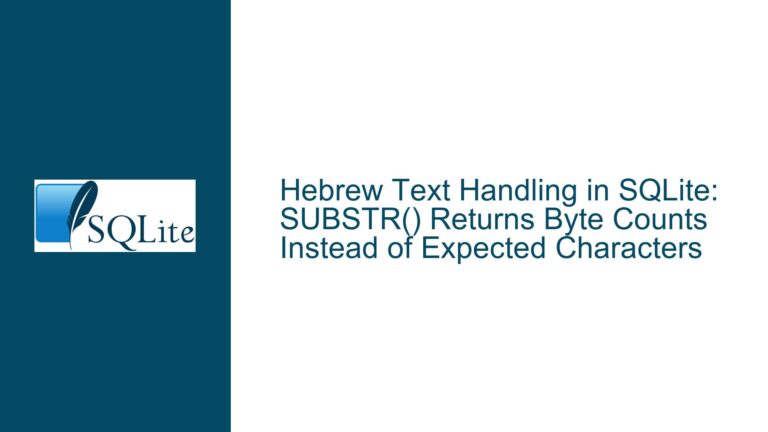Subtracting X Days from a Date Column in SQLite: Troubleshooting and Solutions
Understanding Date Manipulation in SQLite with String-Based Dates
The core issue revolves around manipulating a date column stored as a string in the format YYMMDD in an SQLite database. The goal is to subtract a variable number of days (X) from this date column dynamically during query execution. This requires converting the string-based date into a format that SQLite can recognize and manipulate, performing the date arithmetic, and then filtering the results based on the calculated date range.
The challenge lies in the fact that SQLite does not natively support date columns stored as strings in non-standard formats. Therefore, the solution involves transforming the string into a valid date format, performing the necessary date arithmetic, and then converting it back into the desired format for comparison or display. This process requires a deep understanding of SQLite’s date and time functions, string manipulation functions, and the nuances of handling dates in different formats.
Possible Causes of Issues When Subtracting Days from String-Based Dates
One of the primary causes of issues in this scenario is the use of a non-standard date format (YYMMDD) stored as a string. SQLite’s date and time functions expect dates in a specific format (YYYY-MM-DD), and any deviation from this format can lead to errors or incorrect results. Additionally, the use of reserved keywords like Date as column names without proper quoting can cause syntax errors.
Another potential issue is the handling of two-digit years. Since the year is stored as YY, there is ambiguity about the century (e.g., 22 could mean 2022 or 1922). This ambiguity can lead to incorrect date calculations, especially when dealing with historical or future dates. Furthermore, the lack of proper timezone handling can result in discrepancies when comparing dates, as SQLite’s date('now') function returns the current date in UTC by default, not the local time.
The dynamic nature of the query, where the number of days to subtract (X) is variable, adds another layer of complexity. SQLite does not support variables directly within queries, so the value of X must be passed in through parameters or constructed dynamically using string concatenation. This can lead to issues with query readability, maintainability, and potential SQL injection vulnerabilities if not handled properly.
Detailed Troubleshooting Steps, Solutions, and Fixes
Step 1: Convert the String-Based Date to a Valid SQLite Date Format
The first step is to convert the YYMMDD string into a valid SQLite date format (YYYY-MM-DD). This can be achieved using SQLite’s string manipulation functions, such as SUBSTR and concatenation. For example:
SELECT Stock,
date('20' ||
SUBSTR("Date", 1, 2) || '-' ||
SUBSTR("Date", 3, 2) || '-' ||
SUBSTR("Date", 5, 2)
) AS fulldate
FROM Stocks;
In this query, the SUBSTR function extracts the year, month, and day components from the Date column, and the date function constructs a valid date string. The '20' prefix is added to convert the two-digit year (YY) into a four-digit year (YYYY), assuming the dates are in the 21st century.
Step 2: Perform Date Arithmetic to Subtract X Days
Once the date is in a valid format, you can use SQLite’s date arithmetic functions to subtract X days. There are two primary methods for this:
- Using Julian Day Numbers: SQLite’s
juliandayfunction converts a date into a Julian day number, which can be manipulated using arithmetic operations. For example:
SELECT Stock,
date(julianday('20' ||
SUBSTR("Date", 1, 2) || '-' ||
SUBSTR("Date", 3, 2) || '-' ||
SUBSTR("Date", 5, 2)
) - 10) AS newdate
FROM Stocks;
In this query, julianday converts the date into a Julian day number, subtracts 10 days, and then date converts it back into a date string.
- Using Date Modifiers: SQLite’s
datefunction supports modifiers that allow you to add or subtract days directly. For example:
SELECT Stock,
date('20' ||
SUBSTR("Date", 1, 2) || '-' ||
SUBSTR("Date", 3, 2) || '-' ||
SUBSTR("Date", 5, 2),
'-10 days'
) AS newdate
FROM Stocks;
Here, the '-10 days' modifier subtracts 10 days from the date.
Step 3: Filter Rows Based on the Calculated Date Range
To filter rows based on a dynamic date range (from X days ago to today), you can use the BETWEEN operator with the calculated dates. For example:
SELECT *
FROM Stocks
WHERE date('20' ||
SUBSTR("Date", 1, 2) || '-' ||
SUBSTR("Date", 3, 2) || '-' ||
SUBSTR("Date", 5, 2)
) BETWEEN date('now', '-30 days') AND date('now');
In this query, date('now', '-30 days') calculates the date 30 days ago, and date('now') gets the current date. The BETWEEN operator filters rows where the Date column falls within this range.
Step 4: Handle Two-Digit Years and Century Ambiguity
To handle the ambiguity of two-digit years, you can use a conditional statement to determine the correct century based on a cutoff year. For example, if you assume that years greater than 60 belong to the 20th century (e.g., 64 means 1964), you can use the following approach:
SELECT Stock,
date(
CASE WHEN CAST(SUBSTR("Date", 1, 2) AS INT) > 60 THEN '19' ELSE '20' END ||
SUBSTR("Date", 1, 2) || '-' ||
SUBSTR("Date", 3, 2) || '-' ||
SUBSTR("Date", 5, 2)
) AS fulldate
FROM Stocks;
This query uses a CASE statement to prepend '19' or '20' to the year based on the cutoff value.
Step 5: Dynamically Pass the Number of Days (X) as a Parameter
To dynamically pass the number of days (X) as a parameter, you can use SQLite’s support for bound parameters. For example, if you are using a programming language to construct the query, you can pass X as a parameter:
SELECT *
FROM Stocks
WHERE date('20' ||
SUBSTR("Date", 1, 2) || '-' ||
SUBSTR("Date", 3, 2) || '-' ||
SUBSTR("Date", 5, 2)
) BETWEEN date('now', ? || ' days') AND date('now');
Here, ? is a placeholder for the parameter X, which can be passed in by the application code. Alternatively, you can use named parameters:
SELECT *
FROM Stocks
WHERE date('20' ||
SUBSTR("Date", 1, 2) || '-' ||
SUBSTR("Date", 3, 2) || '-' ||
SUBSTR("Date", 5, 2)
) BETWEEN date('now', :days || ' days') AND date('now');
In this case, :days is the named parameter that contains the value of X.
Step 6: Ensure Proper Timezone Handling
To ensure that the date calculations are based on the local time rather than UTC, you should use the 'localtime' modifier. For example:
SELECT *
FROM Stocks
WHERE date('20' ||
SUBSTR("Date", 1, 2) || '-' ||
SUBSTR("Date", 3, 2) || '-' ||
SUBSTR("Date", 5, 2)
) BETWEEN date('now', '-30 days', 'localtime') AND date('now', 'localtime');
This query ensures that the date calculations are based on the local timezone of the system running the query.
Step 7: Optimize the Query for Performance
When working with large datasets, the performance of the query can be a concern. To optimize the query, consider the following:
- Indexing: Ensure that the
Datecolumn is indexed to speed up the filtering process. However, since theDatecolumn is stored as a string, you may need to create a functional index based on the transformed date:
CREATE INDEX idx_stocks_date ON Stocks (
date('20' ||
SUBSTR("Date", 1, 2) || '-' ||
SUBSTR("Date", 3, 2) || '-' ||
SUBSTR("Date", 5, 2)
)
);
Precompute Dates: If the date range is fixed or changes infrequently, consider precomputing the start and end dates and storing them in variables or temporary tables to avoid recalculating them in every query.
Avoid String Manipulation in WHERE Clauses: If possible, avoid using string manipulation functions like
SUBSTRin theWHEREclause, as they can prevent the use of indexes. Instead, preprocess the data to store dates in a standard format.
Step 8: Handle Edge Cases and Validation
Finally, ensure that your query handles edge cases and validates the input data. For example:
- Invalid Dates: Ensure that the
Datecolumn contains valid dates. You can use thedatefunction to validate the dates:
SELECT *
FROM Stocks
WHERE date('20' ||
SUBSTR("Date", 1, 2) || '-' ||
SUBSTR("Date", 3, 2) || '-' ||
SUBSTR("Date", 5, 2)
) IS NOT NULL;
- Empty or Null Values: Handle cases where the
Datecolumn may be empty or null:
SELECT *
FROM Stocks
WHERE "Date" IS NOT NULL AND "Date" <> ''
AND date('20' ||
SUBSTR("Date", 1, 2) || '-' ||
SUBSTR("Date", 3, 2) || '-' ||
SUBSTR("Date", 5, 2)
) BETWEEN date('now', '-30 days') AND date('now');
- Future Dates: If your dataset may contain future dates, ensure that your query logic accounts for this possibility.
Conclusion
Subtracting X days from a date column stored as a string in SQLite requires careful handling of date formats, string manipulation, and date arithmetic. By following the steps outlined above, you can transform the string-based date into a valid SQLite date, perform the necessary calculations, and filter the results dynamically based on a variable number of days. Additionally, by addressing potential issues such as century ambiguity, timezone handling, and query optimization, you can ensure that your solution is robust, efficient, and reliable.






